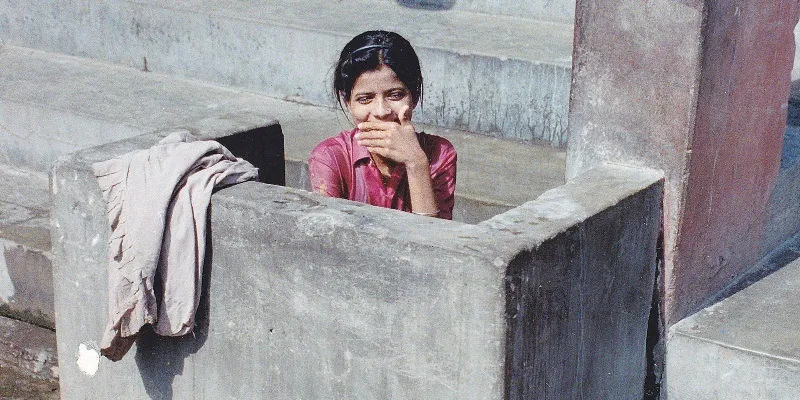Not a Prem Katha everywhere: half of the toilets built in schools remain unused
In India, half of its citizens – over 600 million – do not have toilets. What implications this seemingly simple problem might have on the most vulnerable section of our population – the children?

Between December 2013 and March 2015, as many as 171 children were reported to have gone missing in the forest near Shahbad Dairy, a slum in outer Delhi. More horrifying was the fact that five children — four of them below 10 years — were killed, 28 were raped, and 17 sexually abused. Sixty-six out of them never returned to their families. The reason why they were allowed to go to the forest in the first place was ‘simple’ and utterly disappointing – their shanties in the slums did not have toilets and the forest was the only nearby place where they could go to answer nature’s call.
Shahbad Dairy, in Rohini, is an intervention area of ‘Saksham’, a project supported by Child Rights and You (CRY). A survey carried out by the NGO reveals that at least 45 percent of women and children are forced to either skip meals or eat less after dusk sets in. The end result is that Shahbad Dairy has fallen prey to malnutrition and many children in the area are underweight. The good news is that the government has now taken notice of the issue and is trying to address it by building toilets in the slums.
The bad news, however, is that the above-mentioned story is just one example from a semi-urban locality, which is just a few kilometers away from the administrative nerve-centre of the country – and the implications are manifold. While safety of girl children is a huge concern, we can already see how deeply it is linked to health aspects. Open defecation, as we all know, is one of the major reasons why India has the highest number of diarrhoea deaths. This forms a vicious cycle which leads to vulnerability amongst children leading to malnutrition, stunting and other associated infections such as pneumonia. This doesn’t stop here; diarrhoea and worm infections are the two major health conditions that impact the schoolgoing children’s learning abilities.
This section of the population does not go to the ‘pay and use’ toilets around. Simply because, to avail this facility, an average family of four usually has to spend around Rs 25 to Rs 30 every day, which they often find difficult to afford. Why they don’t have free toilet and washroom facilities in such areas, while you can always have one at plush shopping malls and business centers all across the city, is, however, a different question that remains to be answered.
Recent statistics do show a marked improvement in the number of toilets built across the country, especially since the commencement of ‘Swachh Bharat’ initiative by the government. And there is no denying the fact that we have come a long way in addressing the issue of lack of toilets in schools as well, over the last few years. However, the on-ground reality in terms of access and usability still remains an unfulfilled promise.
A micro-level survey conducted by CRY and its partner organisations in 190 schools across 13 districts in Madhya Pradesh reveals significant infrastructural gaps in RTE compliances. Findings reveal that in 49 percent of the schools’ toilets remain unused. None of the schools reportedly have provision for toilet cleaning staff. Findings of a similar study done by CRY and its partner NGOs in 70 schools of three districts in Rajasthan show that even though separate toilets for girls are available in 69 schools, 21 of them are in completely unusable condition with no provision for regular cleaning and running water facility, broken doors and window-panes hardly ensuring privacy and safety of the girls. Yet another small-scale study on the status of toilets in schools done by CRY and one of its partner organisations in 22 villages at Badaun, Uttar Pradesh, unfolds almost a similar story, where 20 among 28 primary and upper-primary schools don’t have separate toilet for girls and in 20 schools there is no provision of water at the point of access.
This brings us to the more fundamental question that if the aim is to build more toilets, or is it about getting more people to use them. As of now, the narrative seems to highlight how many toilets are built – often aiming largely at the points of access. However, on-ground experience from the intervention areas of CRY suggests that more focus is needed on changing mindset and behaviour patterns of people, when it comes to using toilets on a regular basis. When schools have proper and usable toilets, its health and hygiene implications are manyfold and far-reaching. But more importantly, it is a subtle yet pronounced way in which the schools can respect the dignity of the students. For boys, it does help build awareness that it is not alright for them to urinate in the open, and for girls, needless to say, the impact is much bigger.
When there are no separate toilets for girls, or the existing ones either unusable or broken, not only is that a hygiene issue for them, but also a larger threat that impacts their safety and protection. Given the horror stories of rape and sexual abuse we hear every other day, can one blame parents if they get their daughters to drop out of school on account of non-functional, broken toilets? Moreover, in a country where breaking myths and taboos around menstruation is a huge challenge, why would girls want to continue school once they reach puberty, if there are no clean toilet facilities available? In a country with a long history of discrimination – where to fight superstitions, traditions and gender inequality from the time a girl is conceived – being able to send her to school is a huge achievement in itself. Even bigger is the achievement of helping her dream and fuel her ambition. If after such major breakthroughs, a girl has to drop out of school just because the school cannot give her the sanitation provisions she requires once she reaches her puberty – the dropping out stands as an utter failure for the entire system.
The need of the hour is to focus equally on increasing the functionality of the toilets being built, increasing access to more people, ensuring that there is enough water in the toilets and, most importantly, encouraging more people to use toilets. Also, to bring things into perspective, it’s equally important to build provision of water sources dedicated for drinking. If people keep on using the same pond for bathing cattle and for drinking water, the basic purpose of the whole initiative is completely defeated.
It is also imperative, that these habits are formed during childhood. In order to aim at societal behaviour change on a long-term basis, children have to be taken into account. Unless backed by the political will and proper budgetary investments, the required awareness about the seriousness of the problem can never be created.
Disclaimer: The views expressed by the author are his own and do not necessarily reflect that of YourStory.











